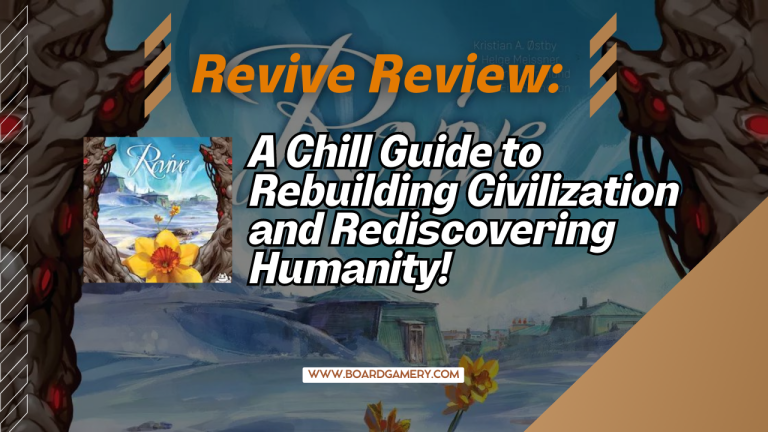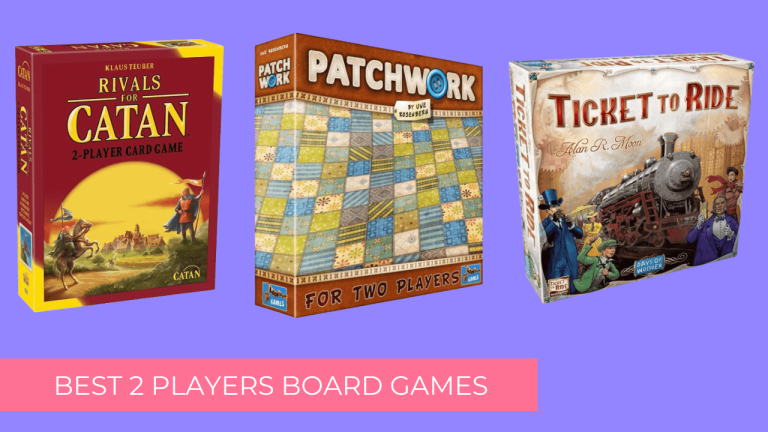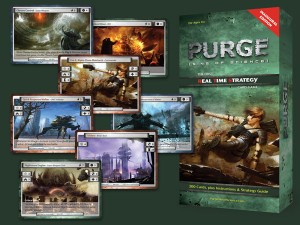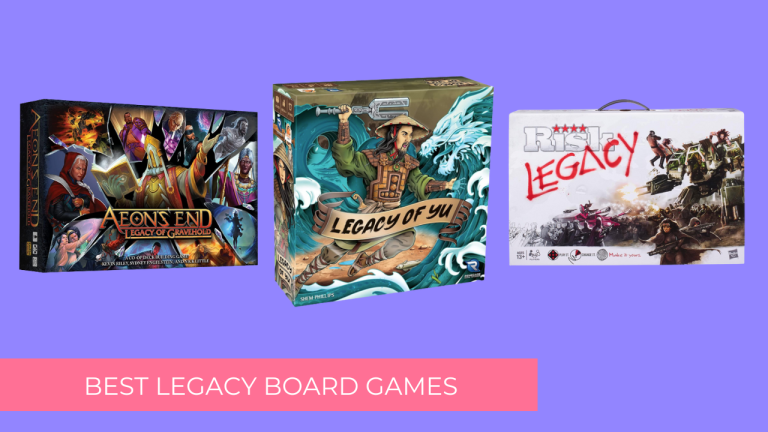Eclipse Board Game | The no-nonsense overview I wished I had found elsewhere.
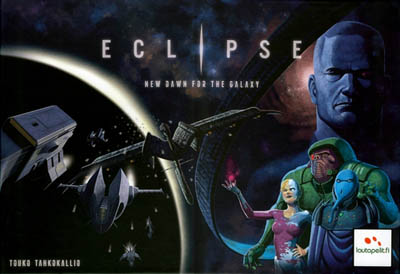
Eclipse. What’s precisely going on here anyway?
QuickFacts:
Board Game Geek: http://www.boardgamegeek.com/boardgame/72125/eclipse
Dice Tower Review: http://www.youtube.com/watch?&v=uS157k0m-YU
Preface / Intro Ramblings
OK, So I’ve played quite a number of fairly involved Euros in my day. Puerto Rico, Caylus, Agricola, Railroad Tycoon, Brass, etc. Diving into one of these bad boys for the first time inevitably involves some combination of reading a lot of reviews on BGG, watching tutorial videos, reading the directions, and having the rulebook splayed out for the first run-through, ready for reference. I’m very appreciative of the wide array of resources that this thing the kids call the “interweb” provides for us, but often feel like reviews and tutorials of games with a good number of moving parts seem to always get bogged down trying to either explain EVERYTHING from the manual without the right big-picture perspective or alternately just talks about the fun of a game and it’s theme and who laughed what liquid out their nose the last time they played. What follows is my attempt to lay down for you major recurring theme of gameplay of Eclipse that is not spelled out in other reviews. You will still need to read the rules and most likely watch some of the youtubes but this is the oh-I-see-what-you-are-doing-here game-schtick that I wish I had known earlier.
The General Skinny of Eclipse.
Here we go. Forgetting the outter-spacey theme, forgetting the much touted “explore, expand, exploit, exterminate” tagline, forgetting the pew-pew battle component, forgetting the 900 pieces of cardboard and plastic in the box, Eclipse is at it’s most essential a *dependency management engine game*. You know what I mean … kinda “I’d want to make these things to get victory points, but in order to make them I first need to have done this other thing, and to have done that other thing I would have needed these advanced widgets which I converted from boring entry-level widgets last turn with my widget upgrader factory I built two turns ago.” I don’t mean any of this in a bad way, I think it’s pretty awesome actually, but I don’t think it’s quite the way the game is most commonly presented in reviews or tutorials. Keeping this idea in mind though, everything becomes a bit clearer.
What is the end goal here?
After 9 rounds of play, each involving a bunch of actions by each player and some combat blowupitude, the game is over. Whoever has the most victory points is the winner. The lion’s share, if not all of these victory points will be won in the center of the gaming table on the sector hexagons where the fighting and owning-of-things happens. That is the bottom line you need to know.
Ok, So what’s this dependency management stuff then?
Along the way, in order to “win” said victory points, you will need to be managing a progression of things on those hexagons and on your player board. These things are not however framed in the familiar themes of commodities or economics that you are probably used to, but serve a similar (but more clever and fun) function.
Currencies
There are essentially three “currencies” in eclipse. These are generated by deploying your population cubes from orange, pink, and brown tracks from your personal player board to the centralized hexagons in the middle of the table where the fighting and territory controlling goes down. Each hexagon has a different number of color-coded spots on it for cubes to go, matching the color tracks on your player board. The more of any given colored track you deploy to the hexes, the more of that type of currency you have to spend on …. stuff. (The thematic idea is that your deployed orange dudes are toiling away in some undoubtedly unregulated and perilous orange-resource-generating enterprise on distant planets, sending back gray market orange resources which you can then spend back in player board central land.)
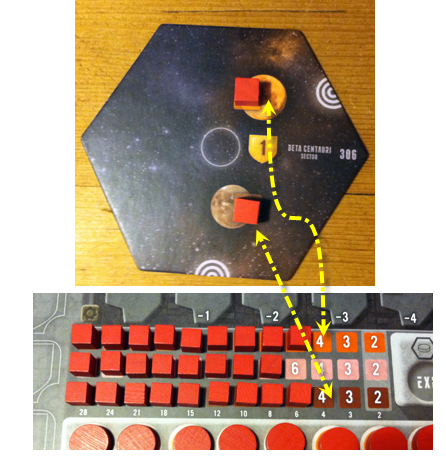
Get resources from deploying onto hexes. This hex happens to not have any pink planets but trust me, they exist and work the same way.
Orange resources are used to pay for the upkeep of your empire at the end of each round. Each round’s fundamental actions as well as controlling booty-generating hexagons cost orange. This is mandatory stuff and easy to see on the player board, in fact all of these currency costs are very nicely displayed. Orange is ‘Money’ in the manual.
Pink resources you will need in order to research (aka buy) technology levels of do-ability from the separate communal marketplace gameboard. While a few have handy common-action-related effects, most of these are levels are simply enablers that then allow you, in future actions, to upgrade various bits of your combat ships in you need for hexagon military badassery. Interestingly the actual action of the upgrading of the ship parts doesn’t have a cost associated with it, but bumping up the research technology level that allows you to do such a thing does. Pink is ‘Science’ in the manual.

Tech tiles go here and are researched with “Science” aka pink cubes
Brown resources are used to buy these various ships so you can then later deploy them to the foreboding inky blackness of alien space where no one can hear you scream and shit like that. Brown is ‘Materials’ in the manual.
So in summary, you need orange every round to do general accounting. You buy ships with brown that become better over time via upgrades. You enable these upgrades by spending pink to research your way through the upgrade tech tree.
Ship upgrade energy dependencies.
This one is pretty simple but important. The ship upgrades you can make after researching the corresponding technologies may very well make or break your military campaigns which in the end are where the real glory, bragging rights, future exaggerated stories and most importantly, victory points come from. In order to upgrade your hot spaceship whips though, you need to generate enough energy (symbolized by the Shazam lightning-bolt glyph) to power all of your accessories. Makes sense. A beginning ship’s blueprint layout on your player board will look something like this, with just enough energy being produced by its standard nuclear source to support its constituent bits.
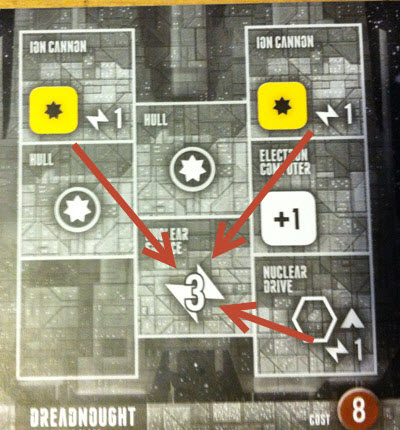
Power produced vs. power needed
As you go to make your upgrades, you will need to make sure that first off you have enough energy being generated to power your intended acquisitions. If not, you’ll need to first upgrade or add to your energy production itself to be able to handle the burden that comes commensurate with increased military funk.
Naturally, there is a lot more this game that just cube management and expenditure, but hopefully this post can serve to warm a new player up to the general resource dependency aspect of the game. Stay tuned for a take on eclipse combat in the future.

